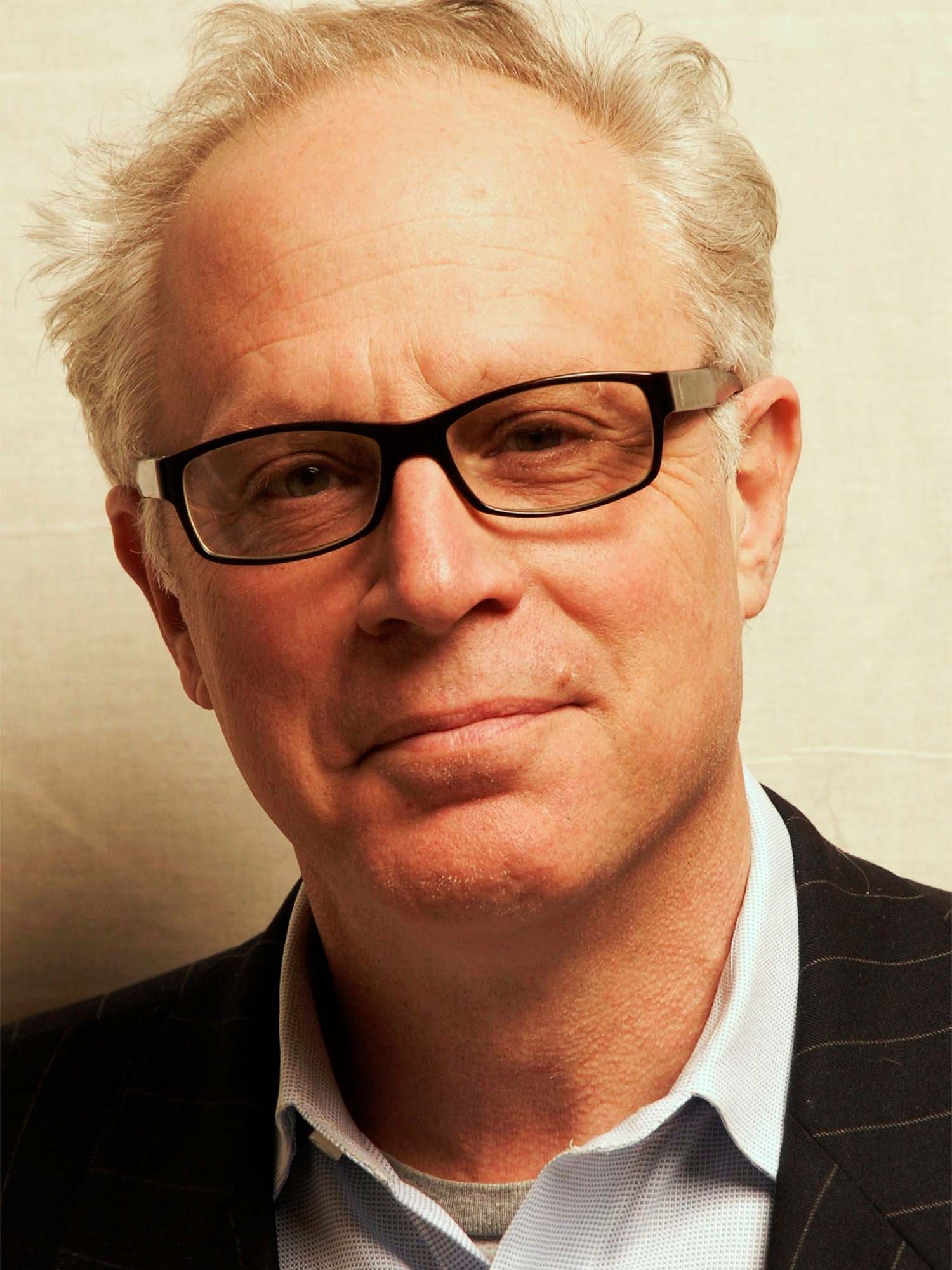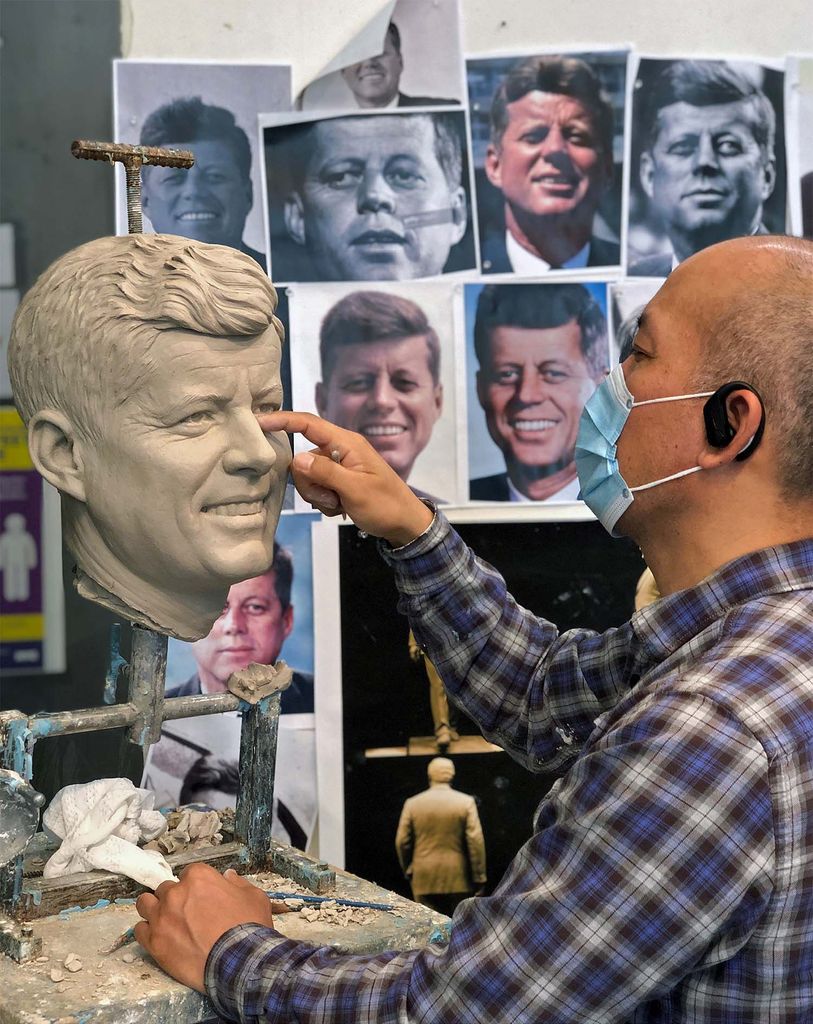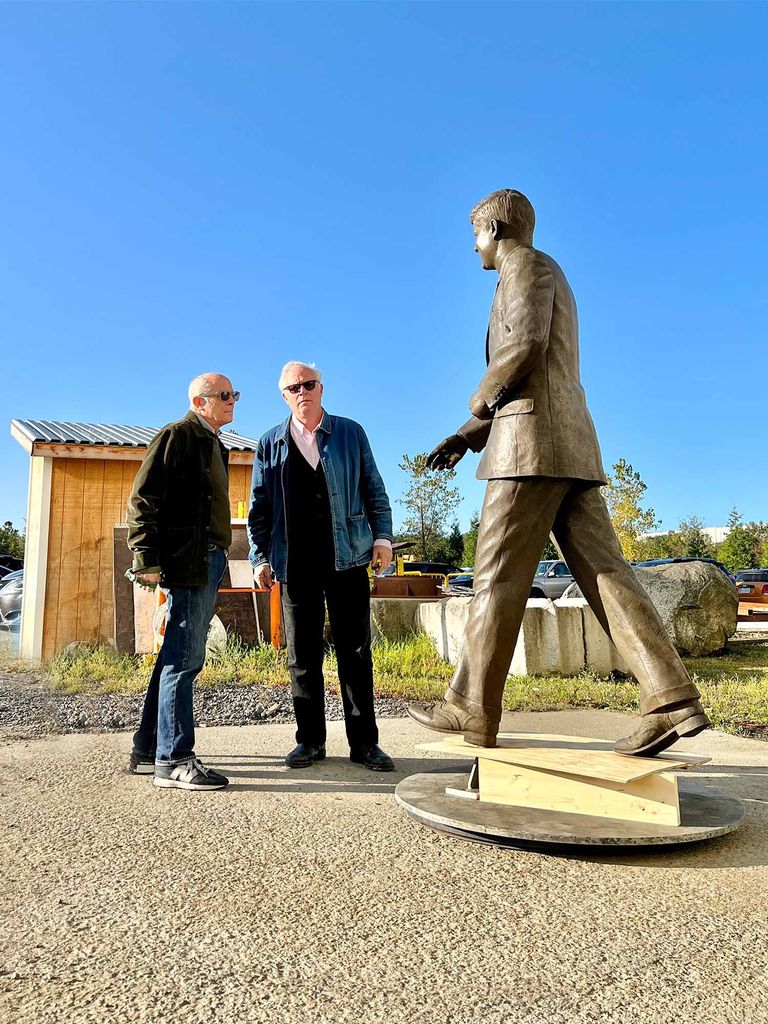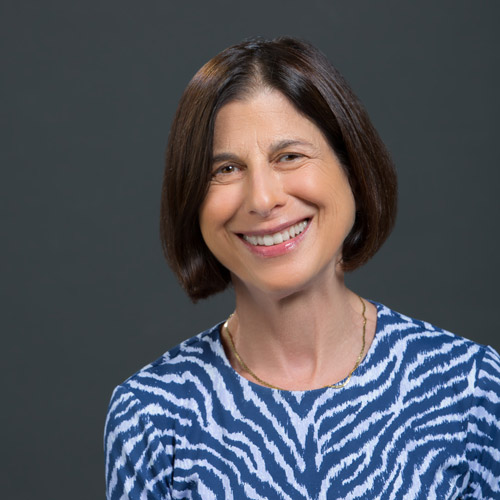Lincoln to Tubman to JFK, Alum Sculpts US History’s Most Famous Figures

Ivan Schwartz and his team at StudioEIS sculpted a seven-foot-high bronze statue of President John F. Kennedy for the 50th anniversary celebration of Washington, D.C.’s Kennedy Center for the Performing Arts. Photos courtesy of Ivan Schwartz
Lincoln to Tubman to JFK, Alum Sculpts US History’s Most Famous Figures
Ivan Schwartz’s latest sculpture, of President John F. Kennedy, will be unveiled in a private ceremony Saturday in Washington, D.C.
Ivan Schwartz tells stories about American history through his sculptures, which stand in museums and public spaces across the nation, depicting historical figures from Thomas Jefferson and the other signers of the Declaration of Independence to Abraham Lincoln to antislavery crusaders Frederick Douglass and Harriet Tubman. On Saturday, December 4, the John F. Kennedy Center for the Performing Arts in Washington, D.C., will unveil Schwartz’s latest work—a seven-foot-tall bronze sculpture of President John F. Kennedy (Hon.’55), which the center commissioned in honor of its 50th anniversary celebration.

Schwartz (CFA’73) and his team began their yearlong work on the sculpture at StudioEIS, in Brooklyn, which Schwartz runs with his brother, Elliot, and sister, Debra, and they completed the statue at the UAP Foundry in upstate New York. The siblings pride themselves on the deep research behind their work—their team includes historians as well as sculptors, costume experts, foundry partners, and other specialists. “While most people are looking for the mythical singular talent, when my brother and I set up the studio, we knew this wasn’t what it was about, that it would be a collaborative effort, requiring the talents of many people,” Schwartz says.
The StudioEIS team has completed work commissioned by a number of institutions, including the National Constitution Center in Philadelphia, the National Museum of African American History and Culture in Washington, D.C., the Virginia Women’s Monument in Richmond, Va., and the National World War II Museum in New Orleans.
Schwartz, who was born in Brooklyn and raised in Queens and on Long Island, has been a visual storyteller for half a century. He is the recipient of a College of Fine Arts Distinguished Alumni Award, a former member of the CFA dean’s advisory board, a past president of Innovators in America, and the author of a visual memoir, Scratching the Surface (7 Days Publishing, 2021).
Bostonia talked with him about the new statue, his creative process, and how CFA ignited his passion for sculpting.
Q&A
With Ivan Schwartz
Bostonia: How old is JFK in your statue and how did you think about how to represent him?
Ivan Schwartz: He’s in his early 40s. We looked at just about every single photograph of JFK that we could find and we watched film of him. The first part of our job was to suggest an attitude for the sculpture. What we didn’t want to do was to create a site of mourning.
Kennedy was telegenic. The camera loved him. He was enormously attractive, compelling, vigorous. We wanted to represent that vigor—having him walking, smiling, very naturalistically, the guy we remembered. He’s got his left hand on his jacket. He used to play with his coat buttons; that was one of the idiosyncratic things he did.
Bostonia: What about Kennedy’s hair—how did you handle that?
Ivan Schwartz: Kennedy had extraordinary hair, which was very thick, very well groomed. You can only approximate that. While we can make almost facsimile copies of clothing, we use clay to sculpt hair and hair doesn’t really want to be re-created in clay.



StudioEIS head sculptor Jiwoong Cheh, working on the President John F. Kennedy statue in clay (left). A seven-foot-high bronze statue of JFK that Ivan Schwartz and his team sculpted for the 50th anniversary celebration of Washington, D.C.’s Kennedy Center for the Performing Arts (center). Statue of Harriet Tubman, which currently resides at the Maryland State House (right).
Bostonia: You were a boy when Kennedy was elected president, in 1960. What did he mean to you growing up?
Ivan Schwartz: I was born a couple years after the end of World War II. My father was a WWII veteran, so to see this young guy who was also a veteran—he represented a kind of new image in terms of the promise of a new America. I think people were hopeful. It was a time when they believed their politicians would deliver on their promises.
Bostonia: How did you become interested in art as a kid growing up in New York?
Ivan Schwartz: My parents dragged us to museums. My mother was a kind of Sunday painter. She had an easel in the corner of the kitchen and she made copies of French Impressionist paintings. I was 11 or 12 when I started taking the subway to an art school in the Ansonia Hotel, on the Upper West Side of Manhattan. I was painting and drawing. I was extremely fortunate in high school—I went to John F. Kennedy High School on Long Island—to have an art teacher who thought art was the most important thing in the world. He recognized that some of us had a serious interest in art. He said, “You guys have a gift, you need to do this.”


Ivan Schwartz and his brother, Elliot, visiting the foundry in upstate New York where the JFK statue was finished (right).
Bostonia: How did BU and CFA shape you as an artist?
Ivan Schwartz: I remember taking my first sculpture class and thinking, this is it. I had two really great sculpture teachers, Elbert Weinberg and Harold Tovish. When I finished my senior year at BU, in sculpture, Tovish said, “You’re the one who’s got the talent, you need to go to New York and become the next great figurative sculptor.” It’s very heady stuff when your professor says that. I had great training in classical study in terms of academic art. After I graduated, I spent a year in New York working as a laborer, making money so I could go to Italy. I spent a year in Italy working in quarries and foundries. That was my graduate school.
Bostonia: How did you get into the work of historical sculptures?
Ivan Schwartz: There was suddenly a new language in visual storytelling that museums were looking for. Figurative elements became important. What happened was that after America’s bicentennial, in 1976, there was a great burgeoning interest in cultural institutions throughout America. There was a flourishing of museum-building over 20, 25 years. Suddenly it was essential for every town of every size to have a museum. I came along at precisely the right moment, when these exhibition designers were looking for a more serious approach to three-dimensional figures.
Bostonia: What are you working on now?
Ivan Schwartz: A big civil rights project: the Clara Luper Memorial in Oklahoma City. Clara Luper was an educator who lived in Oklahoma City. In 1958 she took some Black theater students to New York; they had never been to a lunch counter because of segregation. In New York they were able to go to a Woolworth’s and eat a hamburger and drink Cokes. When they got back to Oklahoma City, she organized a sit-in with 14 kids—they varied in age from 10 to 14 or 15—to desegregate the counter at Katz’s Pharmacy. We’re doing a reconstruction of that 1958 lunch counter and the sit-in.
When you talk about history, these reconstructions are all part of the story that needs to be told. I did the Frederick Douglass and Harriet Tubman sculptures for the Maryland State Archives only two years ago. That was a great honor. The dedication took place at night at a joint session of the Maryland state legislature. I was asked to speak. The descendants of Frederick Douglass and Harriet Tubman were there. These sculptures would never have happened 10 years ago.

Comments & Discussion
Boston University moderates comments to facilitate an informed, substantive, civil conversation. Abusive, profane, self-promotional, misleading, incoherent or off-topic comments will be rejected. Moderators are staffed during regular business hours (EST) and can only accept comments written in English. Statistics or facts must include a citation or a link to the citation.